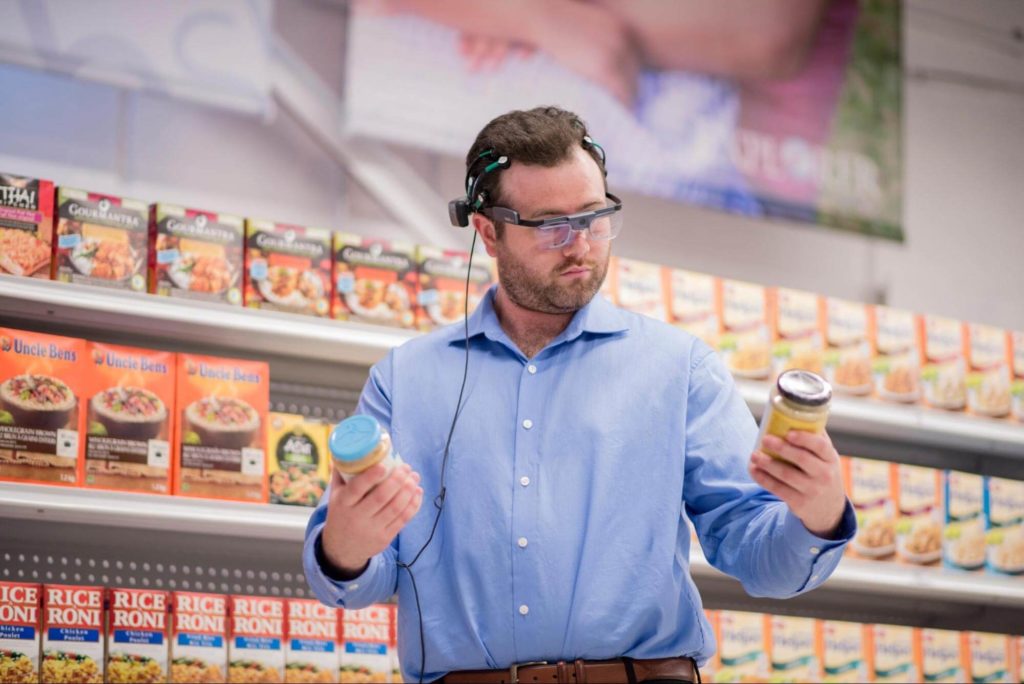Neuro Package Testing combines neuroscience and package testing to understand how different packaging design elements influence consumer perception and decision-making.

Consumers decisions are made inside a second, and completely subconsciously. So how can you hope to explain how consumers purchase or do not purchase your products, when they can’t even explain it themselves?
Using Neuroscience, we are able to breakdown split-second decisions to explain the crucial moment of decision making.
What captures attention? What happens when the brand is recognised? And does the consumer demonstrate a subconscious desire for the product?
When the decision making process is automatic, you can’t understand it by asking questions, only by measuring it.
With so much uncertainty bringing a new product to market, using Neuromarketing you can eliminate the doubts and objectively understand what packaging works and what doesn’t.


A Shelf Test combines Eye Tracking and EEG, to test different layout variants for the vital in-store success metrics.
Does my product catch people’s involuntary attention? How easy is my product to find? Do people want to buy my product when they see it?
Using Neuroscience you can design products and packaging that are easy on the brain, and ultimately help drive sales.
Does the packaging catch your eye? Does it display key pieces of information in an easy way?
When they need to, can consumers find your product quickly and easily?
Do consumers recognise the brand when they see the package design? Do they know who makes this product?
Do people show a desire or 'want' for the product when they see it?

Here you can find some of the questions we are asked about Neuro Package Testing on a regular basis.
If you have questions you cannot find here, or elsewhere on our website, please contact us by clicking on the button below.
Package design testing is the process of evaluating the effectiveness and appeal of a product’s packaging design. It can include methods such as market research, surveys, focus groups, neuromarketing and usability testing to gather feedback on the packaging design from consumers and other stakeholders.
The goal of package design testing is to understand how different design elements, such as colour, shape, and text, influence consumer perception and decision-making.
This can provide insight into which design elements are most effective at capturing consumer attention, differentiating a product on the shelf, and communicating key product benefits. The results of package design testing can be used to inform design choices and optimize packaging design to increase sales and brand loyalty.
Neuromarketing package testing is a way of using neuroscience techniques to evaluate and optimize the design of product packaging. This can involve using brain imaging techniques such as fMRI or EEG to measure neural activity and attention as consumers evaluate different packaging designs. It can also include using biometrics and physiological measures such as heart rate, skin conductance, and facial expressions to assess emotional reactions to different packaging designs.
The goal of neuromarketing package testing is to understand how different design elements, such as color, shape, and text, influence consumer perception and decision-making. This can provide insight into which design elements are most effective at capturing consumer attention, differentiating a product on the shelf, and communicating key product benefits.
Neuromarketing package testing can be used in the early stages of packaging design to inform design choices, or it can be used in market research to evaluate the effectiveness of existing packaging designs and identify areas for improvement. It can be especially useful in highly competitive markets where small changes in packaging design can have a significant impact on consumer purchasing decisions.
During a Neuromarketing Package Testing study, we use a combination of Eye Tracking & EEG, as well as self-reported feedback from participants through questionnaires to collect both the subconscious and conscious impact of the creative on the individual.
Interviews, and other qualitative methods, can also be added to complement the data already collected.
During the testing, participants are typically shown a series of packaging designs and asked to evaluate them. While they are evaluating, their neural activity and physiological responses are measured. The data collected is then analyzed to understand how different design elements influence consumer perception and decision-making.
Some common design elements that may be tested include:
The results of neuromarketing package testing can be used to inform design choices and optimize packaging design to increase sales and brand loyalty.
When it comes to testing your packaging designs, you don’t want research to slow you down. A standard Neuromarketing study usually requires 10-14 days, spanning the period from the initial approval through to final presentation of the insights.
Where there is a requirement for a quicker turnaround, we also provide rapid-testing service, where we test through the evening hours to complete the project inside a week.
It is also important to note however, that the number of variants included within the test can have an impact on turnaround times.
It may surprise you but extremely artificial settings – like lying flat in a fMRI machine – is very powerful at predicting the effectiveness of a packaging design.
Regardless, at Future Proof, we believe context is hugely important and we endeavour to create a testing environment that is ‘as natural and non-invasive as possible’.
In addition, where required, we create testing environments that resemble or replicate in-store experiences.
The intention is that respondents can relax, while our equipment records biometric data without the respondent being aware of it.
For updates on our research, analysis & other useful insights. Sign up to our mailing list.
